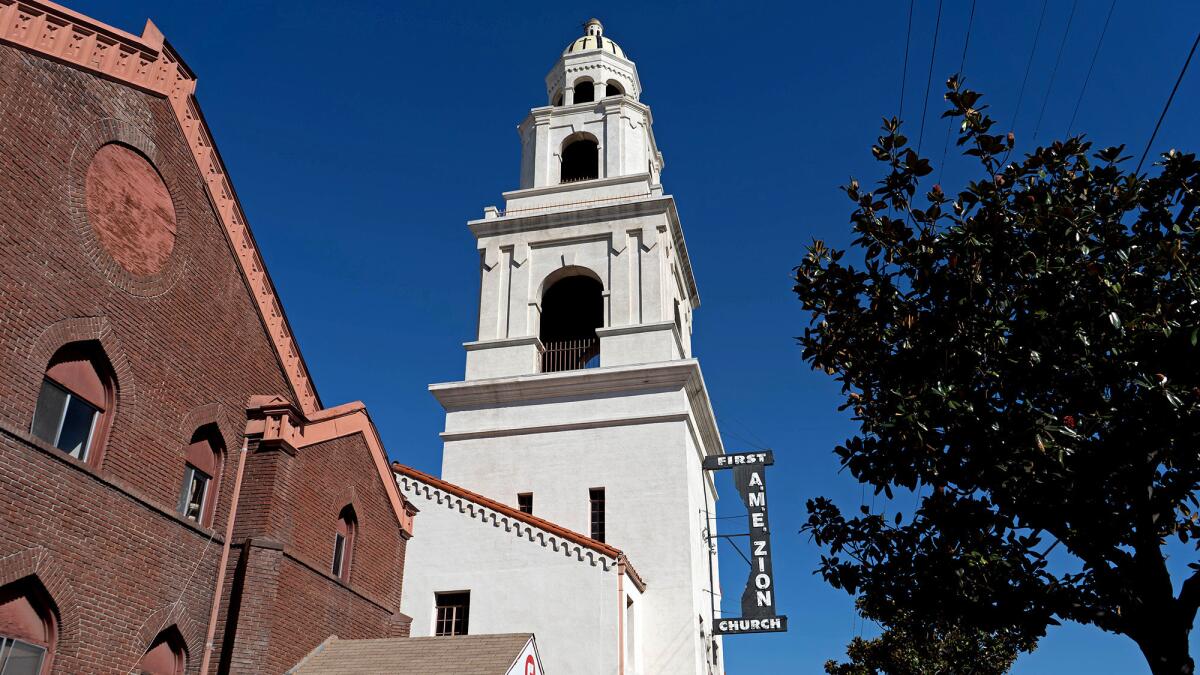Neighborhood Spotlight: Adams-Normandie was once exclusive. Now it’s inclusive.

Close to downtown, and with an abundant supply of developable land, Adams-Normandie instantly became a popular destination for well-heeled Angelenos after its annexation by the city in 1896.
Located in one of the oldest additions to the original Spanish boundaries of Los Angeles, the neighborhood offered more peace, quiet and elbow room than either Bunker Hill or rapidly commercializing Figueroa Street could provide.
The neighborhood was subdivided by George Stimson, one of Pasadena’s foremost developers. In partnership with his architect son, he was responsible for many of that city’s grand homes, including what is now the Millionaire’s Row headquarters of the Tournament of Roses Parade.
Stimson and other developers brought the opulent suburban homes typical of Pasadena to Adams-Normandie, building mansions in a variety of architectural styles including Victorian, Queen Anne, and Greek and Colonial Revival.
The best-known and best-preserved pocket of historic homes in Adams-Normandie is in the Van Buren Place Historic District, a subdivision developed beginning in 1902 by Percy Clark, who would later make another fortune selling land in Beverly Hills.
Clark built half of the homes on Van Buren Place, including his own. Instead of looking to the past for architectural inspiration, he embraced the relatively new and wildly popular Craftsman style.
Tree-lined streets of Craftsman homes would eventually predominate in Adams-Normandie, which, while utterly suburban in character, was knit closely to the city’s commercial heart by a number of streetcar lines.
The development pattern of all Los Angeles grew along such lines, with the arterial streets feeding residential areas and their narrow, walkable commercial strips.
Adams-Normandie remained a prestige address throughout the first half of the 20th century, until changing tastes and the general movement of wealth to the Westside led to a transition in which its mansions were demolished or converted to rooming and apartment houses.
The court-ordered end of L.A.’s discriminatory racial covenants in the late 1940s was a milestone in the neighborhood’s history, as black Angelenos and other people of color were now afforded the same housing rights as whites and were able to freely move into the neighborhood. As a result, many of the remaining white residents decamped to the Valley and other suburbs.
More recently, its plentiful and relatively affordable apartments have made it a popular neighborhood with new arrivals to this country, especially from Mexico and El Salvador. Today Adams-Normandie is one of the most densely populated districts in the city.
Neighborhood highlights
Living history: Adams-Normandie represents more than 100 years of L.A. history, from its early days as a streetcar suburb to its present as a dense, bustling urban neighborhood.
Craftsman legacy: As a repository of Craftsman architecture, Adams-Normandie is nearly unmatched in the city, although many of them have fallen into disrepair.
Location, location, location: With USC, the Coliseum and the Expo Line within walking distance, Adams-Normandie is convenient for college students, sports fans and downtown commuters.
Neighborhood challenges
Faded glory: Economic opportunity is in short supply in Adams-Normandie, which ranks near the bottom of the city’s neighborhoods for median income.
Expert insight
David Raposa of City Living Realty has been working and living in the Adams-Normandie area for 30 years. He said that as nearby communities such as South Park and the Arts District become more popular, the neighborhood doesn’t seem quite as out of the way as it used to be perceived.
“Suddenly, Adams-Normandie is very central because everything else is changing around it,” Raposa said. “It’s no longer on the fringes.”
Thanks to Historic Preservation Overlay Zones — areas of significance protected by the L.A. Planning Department — the neighborhood has kept its stock of late Victorians and Transitional Craftsmans built between 1901 and 1915. Residentially, the area is built out, so there won’t be any new construction unless something’s torn down.
“You’re not seeing the mansionization that others are experiencing. No houses are coming down in favor of uber-contemporary homes with sliding glass doors and pools out back,” Raposa said.
Instead, commercial developments on Western Avenue are popping up, including a boutique hotel in the works near the 10 Freeway and a 1950s hospital being redone as an apartment complex with a rooftop restaurant.
Market snapshot
In the 90007 ZIP Code, based on one sale, the median price for single-family homes in August was $950,000, up 100% year over year, according to CoreLogic.
The closest other ZIP Code is 90018. There, based on 16 sales, the median sales price for single-family homes in August was $695,000, up 19.9% year over year.
Report card
Schools in the Adams-Normandie area include Vermont Avenue Elementary, which scored 790 on the 2013 Academic Performance Index, and Magnolia Avenue Elementary, which scored 770.
Three others in the area scored above 700: Lenicia B. Weemes Elementary at 750, Norwood Street Elementary at 729 and John W. Mack Elementary at 721.
Times staff writer Jack Flemming contributed to this report.






